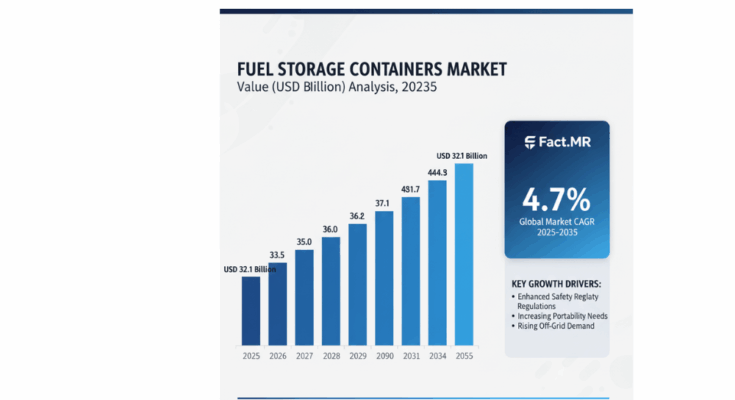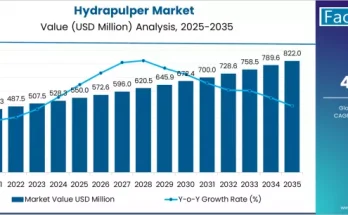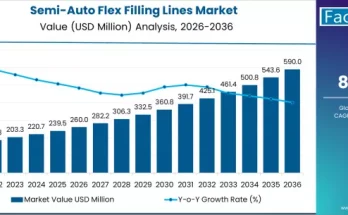The global fuel storage containers market is projected to reach USD 47.3 billion by 2035, up from USD 28.6 billion in 2024, reflecting a robust compound annual growth rate (CAGR) of 4.7% during the forecast period (2025–2035). The market expansion is being propelled by increasing off-grid operations, stringent safety regulations, and rising consumer demand for portable, compliant fuel solutions.
Fuel storage containers have become indispensable in powering generators, vehicles, and emergency equipment, particularly in industrial, agricultural, and consumer sectors. These containers not only support backup power and compliance requirements but also provide portable, safe fuel solutions for recreational and small-scale applications.
Key Market Insights:
-
Market Value: USD 29.9 billion in 2025, projected to reach USD 47.3 billion by 2035
-
Forecast CAGR: 4.7% (2025–2035)
-
Leading Segment: Portable Fuel Containers (36% market share in 2025)
-
Fastest Growing Country: China (5.3% CAGR)
-
Top Industry Players: Magna International Inc., Scepter, Stokota, Justrite
Market Drivers:
The demand for fuel storage containers has intensified due to growing off-grid operations, particularly in remote locations that rely on portable fuel for generators, agricultural machinery, and construction equipment. Additionally, stringent safety regulations across industrial and consumer sectors mandate the use of certified containers that prevent leakage, control gas vapor, and are fire-resistant.
Increasing outdoor activities and individual emergency preparedness have further spurred demand for compact, portable fuel containers. Consumers engaged in off-road recreation, marine activities, and small-scale energy needs seek containers that are safe, transportable, and designed for specific fuel types.
Regional Trends:
-
North America: Adoption is driven by off-grid energy needs, disaster preparedness, and construction applications, with regulations emphasizing industrial and consumer safety.
-
Europe: Market growth is shaped by compliance standards and sustainability initiatives promoting reusable and environmentally friendly containers.
-
Asia Pacific: Expansion is fueled by rural development, agricultural mechanization, and infrastructure projects requiring decentralized fuel storage.
-
Latin America: Demand is rising for remote project support and small-farm operations where formal fuel networks are limited.
-
Middle East & Africa: Market growth is linked to oilfield operations, desert construction, and unstable power supply areas.
Country-Specific Insights:
-
China: The Chinese market is benefiting from government regulations on rural fuel supply, construction site safety, and environmental pollution control. Provinces including Jiangsu, Hunan, and Sichuan are investing in container development centers focusing on fireproof designs and smart monitoring systems, often in collaboration with CNPC and Sinopec-backed ventures. Foldable, stackable, and smart containers are gaining traction, aligning with logistics optimization and e-commerce fleet management initiatives.
-
India: Regulatory reforms and programs such as PM-KUSUM are promoting safe fuel storage across agriculture, transport, and micro-enterprise sectors. States like Maharashtra, Tamil Nadu, and Uttar Pradesh are developing manufacturing hubs for high-quality HDPE containers with easy-fill, stackable designs. Automation in production and GST-funded R&D initiatives are driving innovation in portable, compliant containers for energy and transport sectors.
-
United States: The U.S. market is focusing on certified designs for industrial, domestic, and outdoor applications. States such as Texas, California, and Florida are adopting flame-retardant, vapor-sealed, and user-friendly containers for disaster response, construction, and portable energy systems. Product development emphasizes leak-proof construction, fuel compatibility, and ease of dispensing.
Segment Analysis:
-
Container Type: Portable fuel containers dominate due to mobility, refillability, and compatibility with small engines and generators. Features such as flame-screen vents, ergonomic designs, and sealed caps are increasingly sought after in both industrial and consumer markets.
-
Material: Plastics, particularly high-density polyethylene (HDPE), are preferred due to light weight, chemical resistance, durability, and low maintenance. Blow molding and rotational molding techniques optimize cost and design replicability for various fuel types.
Competitive Landscape:
The market is highly competitive, with manufacturers differentiating through ergonomic designs, safety features, and material compatibility. Key global players include Magna International Inc., Scepter, Stokota, Justrite, Hoyer, 4refuel, Snyder Industries, Time Technoplast Ltd., CEMO GmbH, KingTank, and HighLand Tank LLC. Domestic manufacturers are expanding by catering to local preferences, including capacity, spout design, and stackability, while adhering to environmental and safety regulations.
Recent Developments:
-
In July 2025, Dangote Petroleum plans to construct fuel storage tanks in Namibia with a 1.6 million-barrel capacity to supply southern Africa.
-
In May 2023, IMC Enric Holdings Limited secured significant LNG fuel tank orders for Type B and Type C tanks, demonstrating growing industrial investment in specialized fuel storage solutions.
Methodology:
The report integrates insights from over 12,000 experts across 30 countries, with a structured questionnaire assessing fuel container usage, safety, regulatory compliance, and industry trends. Data was extracted from 280 verified publications, including material safety regulations, field equipment documentation, and government procurement markers. Quantitative modeling and regression-based forecasting were applied to evaluate segment-level performance, offering strategic recommendations for manufacturers, utility service providers, and storage solution developers.
Outlook:
With increasing off-grid operations, regulatory enforcement, and a focus on safety, the global fuel storage containers market is poised for substantial growth over the next decade. Industry leaders are encouraged to innovate with portable, fire-compliant, and environmentally responsible designs to capture emerging opportunities in both developed and developing markets.
Browse Full Report : https://www.factmr.com/report/3729/fuel-storage-containers-market



